Plectranthus coleoides, P. purpuratus, and P. verticillatus
Do you want to grow one of the most famous houseplants in the world, often photographed sitting on the marble mantel across the room from a certain important desk in a certain office of national significance?
Then Plectranthus verticillatus, otherwise known as Swedish ivy or Swedish begonia, is the plant for you.

We link to vendors to help you find relevant products. If you buy from one of our links, we may earn a commission.
And yes, there is – or at least there was, for a long time – one of these plants in the Oval Office.
Reportedly given to John F. Kennedy in 1961 by the Irish ambassador, the Swedish ivy and its offspring have been known to hold a place in the White House ever since. The plant even has an unofficial Instagram page!
Former White House aides and interns have been given clippings of the original plant to propagate over the years.
And while you may not be able to get your hands on an official Oval Office Ivy clipping, you can grow your own Swedish ivy at home.
And who knows? Maybe you’ll be able to pass it down from one generation to the next, much like the United States presidents have.
Ready to get started? Here’s what I’ll cover:
What You’ll Learn
What Is Swedish Ivy?
Though Plectranthus verticillatus is the most common species that you will see grown in the US as a houseplant, other species and hybrids may be referred to as Swedish ivies as well.
They share similar care requirements, and you can find a selection of recommended varieties in the Species and Cultivars to Select section below.
P. verticillatus is an evergreen perennial in the mint family, Lamiaceae, with a lovely, drooping growth habit that makes it ideal for hanging baskets.
Its leaves are small, generally growing one to one and a half inches across. These are broad-ovate, glossy green, and serrated around the edges, and they release a pungent scent when touched.
Other closely related species also referred to commonly as Swedish ivy may have purple leaves, or green foliage with white margins.
You might see this plant labeled P. australis, but according to the experts at the Royal Horticultural Society, this is a misapplied synonym.
The genus name, Plectranthus, comes from the Greek word “plectron,” which means “spur,” and “anthos,” meaning “flower.”
This name references a spur that is often found at the base of the flowers, though many sources describe the flowers as a whole as being spur-shaped.
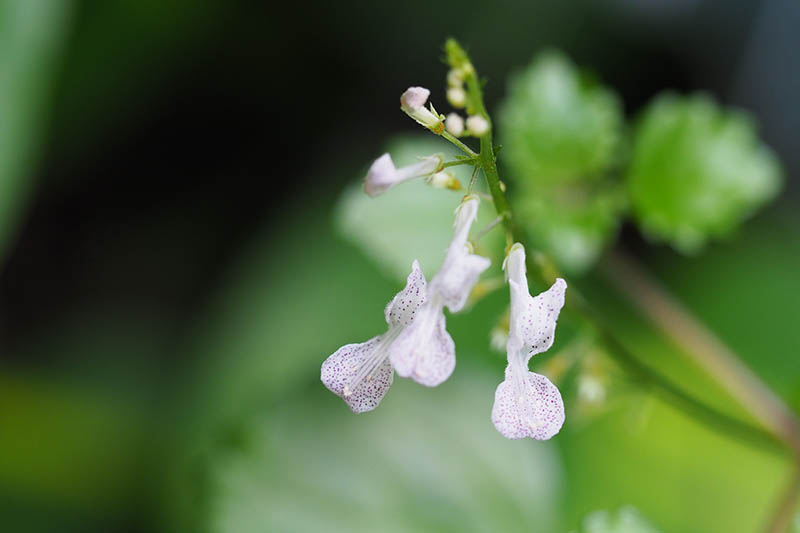
A pet-safe, nontoxic plant, Swedish ivy grows two to three feet tall and wide and produces eight-inch spikes of delicate, pale purple flowers in the fall if moved outdoors for the summer.
Though it’s most often grown as a houseplant in the United States, it can stay outside year-round in USDA Hardiness Zones 10 and 11, according to the experts at the Missouri Botanical Garden.
Its common name, Swedish ivy, is quite the misnomer. The plant is not native to Sweden but to southern Africa, from Mozambique down through South Africa.
Some gardeners believe P. verticillatus was given this seemingly confusing common name because it first became popular as a houseplant in Sweden.
Swedish botanist Vivi Laurent-Tackholm is often credited with introducing several types of Plectranthus to houseplant enthusiasts there during World War II, while others claim Swedish ivy has been in cultivation in Sweden for over 100 years and has been known by this name for nearly as long, perhaps originally brought there by members of the Hermannsburg Missionary Society, or a Swedish surveyor working in Uvongo, a seaside resort in South Africa.
In addition to not having roots in Scandinavia, Swedish ivy is also not a true ivy, or part of the ivy family, Araliaceae, and it doesn’t cling to surfaces as it grows.
Some gardeners also refer to these plants as creeping Charlie, not to be confused with Glechoma hederacea, aka ground ivy.
It’s suited to Zones 10 and 11 for year-round growing outdoors and it has become naturalized in Australia, Central and South America, Puerto Rico, and Hawaii as a plant that adapts easily to warm climates.
It thrives as a houseplant in all zones as long as it receives bright, indirect sunlight for most of the day.
Swedish ivy prefers temperatures between 70 and 75°F during the active growing season in the spring and summer months.
For the rest of the year, indoor temperatures between 60 and 65°F are sufficient. It’s important, says Dr. Perry, to keep the indoor temperature from plunging as low as 50°F, as this can kill the warmth-loving plant.
Propagation
As the Oval Office story suggests, P. verticillatus and several other similar species in the genus are easy to propagate.
The best way to do so is by taking stem cuttings, but Swedish ivy can also be grown from seed. And of course, you can always purchase a specimen from a local nursery or online.
Since purchasing new plants and propagating stem cuttings are the most common ways of getting your hands on your very own P. verticillatus or one of its close relatives, these are the two routes to Swedish Ivyland that we’ll cover.
Via Stem Cuttings
If a friend of yours has a Swedish ivy they’re willing to give you access to – or if you happen to work at the White House and have been allowed to take a cutting from the famous plant in the Oval Office, though the jury’s still out on whether or not it’s still there – here’s how to do it.
First, you can take a cutting at any time during the year. The ideal time is in the spring or summer, during the plant’s active growth season, but you should be able to root cuttings even in the middle of winter.
Prepare a clear plastic cup with holes punched out of the bottom or a nursery pot with drainage holes by filling it with potting mix before you get started. Or, fill a cup with clean water.
Choose a vine with younger, smaller leaves, which indicate recent growth, and take a five- to six-inch cutting. Use clean pruners and cut at a 45° angle above a leaf node.
Remove the leaves from the bottom two inches of the cutting, but leave the rest of the foliage intact. You can dip the cut end in rooting hormone powder if you want, but Swedish ivy propagates so easily that this isn’t necessary.
Place the cutting in the rooting medium or in a container of water so it’s submerged by about two inches.
Set the container on your kitchen table or countertop, in a location where it will receive bright, indirect sunlight without being exposed to drafts.
If you’re using water, change out the old water for a fresh cupful every two to three days. Gardeners who choose to use potting mix will need to keep it consistently moist until roots form.
This should happen within two to three weeks.

If you’re using a clear cup filled with either water or potting mix, you’ll be able to see the new root system as it develops.
For an opaque container filled with potting mix, you may need to gently tug on the base of the plant to test whether or not it has rooted. If you feel any resistance, that’s a sign that your P. verticillatus cutting has taken root!
Select a four- to six-inch container with drainage holes and a dish to place beneath it. Fill it with fresh potting mix. Make a hole the length of the roots and carefully transplant the rooted water-grown stem cutting into its new home.
Cover two inches of the stem with soil, but no more, and put the container back in a place where it will receive four to six hours of bright, indirect sunlight daily.
After about a year, or whenever the roots begin to grow out of the drainage holes in whatever type of container you have selected to start your propagation project, your Swedish ivy will be ready to transplant into a larger pot as described below.
Transplanting
If you’re ready to move your rooted stem cutting into a larger container, or if you’ve brought home a young P. verticillatus or another variety that you want to tuck into a more permanent home, here’s how to do it.
First, select a pot with drainage holes and a detachable drainage dish. A container that’s at least 10 to 12 inches wide and eight inches deep is ideal – remember, this houseplant can grow two to three feet tall and wide.
But you also don’t want to place a small specimen in a large container that contains too much soil, since the health of the roots can be impacted by oversaturation.
You can also prune your plant to keep it smaller (more on that in a moment), but giving it ample space to grow without going overboard is important.
Swedish ivy also shines in a hanging basket where its vibrant leaves can drape over the edges of the pot.

Miracle-Gro Indoor Potting Mix
Fill your chosen container with fresh potting mix. I like to use this indoor potting soil from Miracle-Gro, available in 16-quart bags from Amazon, because it’s designed to be less prone to fungus gnats.
It’s made with a combination of coconut coir, perlite, sphagnum peat moss, fertilizer, and a wetting agent.
Make a hole in the soil that’s as deep and wide as the root ball you’ll be transplanting.
Carefully remove your young P. verticillatus from its pot, using a butter knife to loosen the soil at the edge of the container if you need to. You can also gently squeeze the pot if it’s flexible, to loosen the root ball.
Place the root ball inside the waiting hole and backfill with soil, taking care to avoid covering the stem. Water thoroughly and slowly until you see the water start to fill the drainage dish.
Let the plant sit for about 10 minutes before emptying the dish.
How to Grow
Swedish ivy prefers a soil pH between 5.5 and 6.5, which most potting mixes easily provide. This houseplant grows best with bright, indirect sunlight for four to six hours every day, although it can tolerate lower light conditions.
Swedish ivy prefers high humidity. It will tolerate the lower humidity found in most homes, even during the winter months – although it never hurts to place a humidifier near the plant.
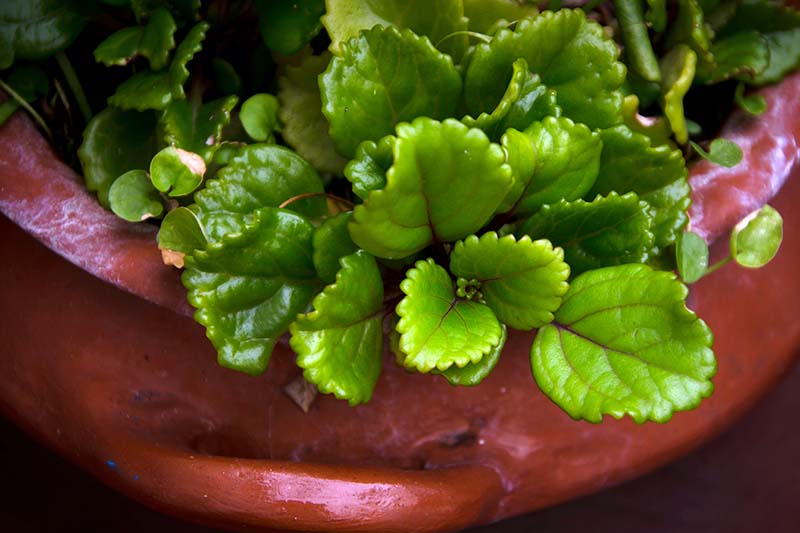
An overly dry plant can attract spider mites. If you keep a humidifier on hand for times when those nasty winter colds hit, like I do, you can put it to use for your plants when you’re not using it in the sickroom!
Overwatering is the number one cause of death for P. verticillatus, according to Dr. Perry as referenced above, so it’s important to follow these watering guidelines:
Water about once a week during the spring and summer, allowing the top couple of inches of soil to dry out before irrigating again. Yellowing leaves are a sign of overwatering, so if you notice this symptom, you’ll need to water even less frequently.
In the fall and winter, you’ll only need to water your plant about once every two to three weeks. It won’t be growing as much during these seasons, and giving it too much water is risky.
Allow the soil to dry out to about twice as many inches deep as you would in the spring between waterings.
If you water so infrequently that the leaves begin to wilt and feel rubbery, go ahead and water your Swedish ivy. But be sure to check the soil moisture first, in case other members of your household may be watering as well.
Wilting can also be a symptom of root rot, common in oversaturated soil.
During periods of active growth in the spring and summer, fertilize your P. verticillatus every two to three weeks with indoor plant fertilizer, like this one from Miracle-Gro that’s available from the Home Depot.
Miracle-Gro Liquid Indoor Plant Food
This 1-1-1 NPK fertilizer comes in an eight-ounce bottle and it is the perfect strength for your Swedish ivy – or in other words, it’s not too strong!
Avoid fertilizing during the fall and winter.
In the summer, you can put your plant in a shady or partly sunny location outdoors for an increasing number of hours each day until it has adjusted to the outdoor conditions and can remain outside full-time.
If you do this, and restrict watering a bit, you may get to see pale purple spikes of flowers after you bring your plant back inside in the fall!
Just remember to bring your houseplant back inside once nighttime temperatures start to drop below 60°F.
Growing Tips
- Water when the top 2-3 inches of soil dry out in spring/summer, or when the top 4-6 inches are dry in fall/winter
- Keep a humidifier on near your plant during the winter
- Fertilize every 2-3 weeks during active growth
Pruning and Maintenance
Swedish ivy is generally a low-maintenance houseplant, but it does need regular pruning.
You don’t have to do anything too complicated, though – just pinch or cut off any leggy or unruly stems every couple of weeks with a sharp, clean pair of pruners.
Select stems that are growing longer than the rest, or that are disrupting the shapeliness of the plant.
Regular trimming will keep it from growing too large and encourage it to branch out. These plants are also great for beginners because they’re able to withstand hard pruning if they become too leggy or require some significant shaping up.
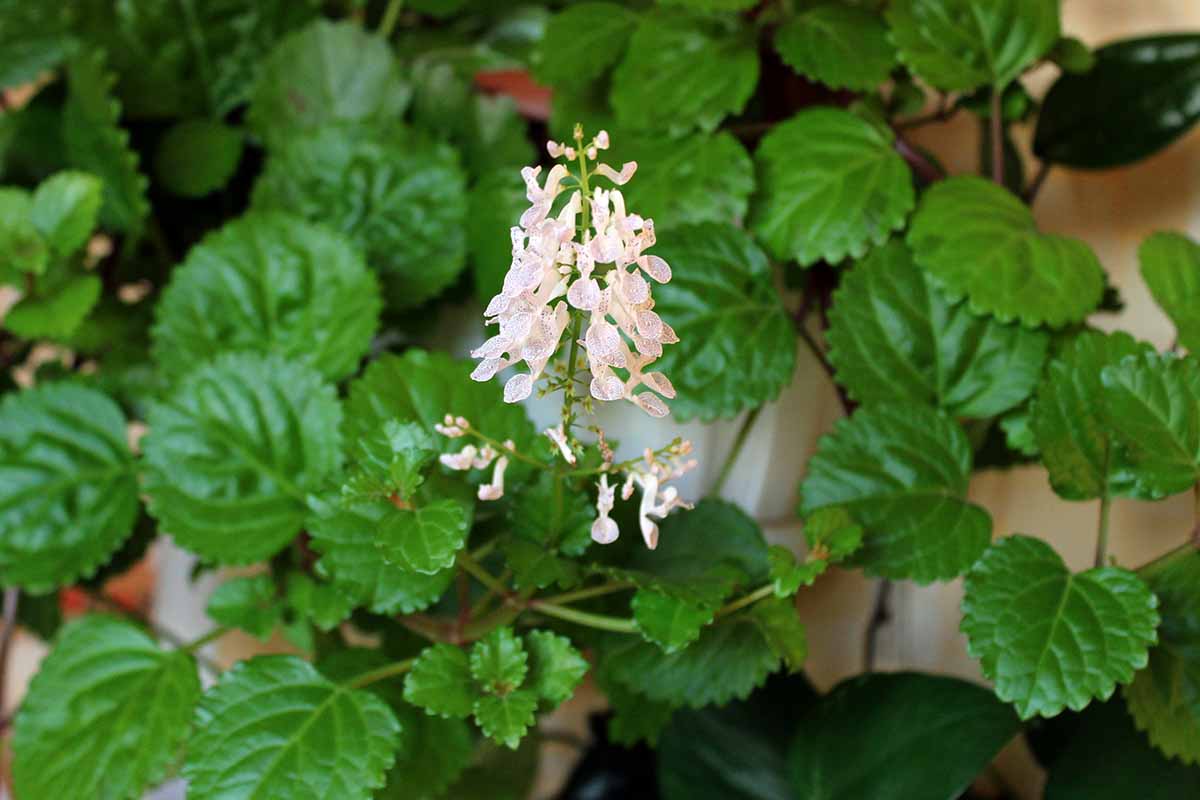
While you’ll probably end up tossing some of those stems out, you can also propagate them to give to your friends and family as gifts.
If your Swedish ivy blooms, pinch back the stems to encourage branching and new growth after the flowers fade. You can read more about deadheading flowering plants in our guide.
After two or three years, or whenever the roots start to poke out of the drainage holes, move your Swedish ivy into a container that’s two inches wider and deeper than its current home.
Make sure the new container has drainage holes and a detachable drainage dish, and fill it with fresh potting mix. Transplant as described above, and water thoroughly.
Water it again every two to three days until you notice new, active growth. Then, slow back down to the normal watering schedule.
It isn’t likely that you’ll need to repot your P. verticillatus again after this, as it only reaches up two to three feet tall and wide at maturity. But refreshing the soil periodically is a good idea, even if you don’t need to size up the pot.
Species and Cultivars to Select
Swedish ivy can be difficult to track down, and though various species of spurflower show promise in commercial cultivation, cultivars and hybrids remain rare in the US market today.
Here, we discuss the types of Swedish ivy that are typically more readily available.
With its uniformly green, scalloped leaves, P. verticillatus can brighten up your home in winter, and make a pleasing, solid-colored anchor for the collection of hanging flower baskets on your porch during the summer.

You can find a two-inch potted Swedish ivy plant from The Plant Store, available via Amazon.
You may also be able to find a cutting by searching your local online marketplace listings. Remember that this plant may also be identified by the names P. australis and Swedish begonia – include these terms in your search for the best chance of finding a match!
A close relative with similar care requirements, P. coleoides ‘Variegata’ also goes by the name “variegated Swedish ivy” or “white-edged Swedish ivy.” It has a similar trailing habit and scalloped leaves. Note that variegated plants may sometimes scorch in direct sunlight.
The main characteristic that distinguishes it from P. verticillatus is that each green leaf has a thin white border at the edge. This fun pop of contrasting colors will be an attention-getter for anyone and everyone who visits your home!
Variegated Swedish ivy grows six to eight inches tall and spreads 24 to 26 inches.
P. purpuratus is another attractive option, if you can find it, with striking purple and dark green leaves. Also known as the Vick’s plant, in reference to the famous mentholated rub, its leaves release a pungent scent when rubbed or crushed.
Managing Pests and Disease
True to its easygoing nature, P. verticillatus isn’t plagued by too many types of pests or diseases. Because it appreciates slightly dry soil, you’ll need to keep an eye out for spider mites (Tetranychidae spp.).
As we mentioned above, a humidifier can help keep the air around the plant moist enough to deter these tiny pests.
If you notice any telltale webbing on the leaves, wipe them away immediately and spray your plant with a miticide, like Bonide’s Mite-X, which is available in 12-ounce bottles from Arbico Organics.
If you notice cotton-like masses on your plant, you’re probably dealing with mealybugs (Pseudococcidae spp.). These pests love warm, wet soil – another reason not to overwater your Swedish ivy.
Remove dead bugs with a wet cloth and spray the plant with insecticidal soap or neem oil to prevent reinfestation.
Root rot and leaf spot are the main diseases to watch out for. Both favor overly wet conditions, so keep your plant’s soil from getting soggy and you probably won’t have any issues.
If you notice spots on the leaves, remove the affected foliage and spray the plant with a copper spray like Bonide’s copper fungicide, which is available in a 16-ounce spray bottle from Arbico Organics.
Root rot will cause your entire plant to wilt, no matter how much you adjust your watering practices. The best course of action is to cut off the healthiest stems and propagate them to start new plants, and then discard the parent.
Best Uses
I think this houseplant would look lovely on a fireplace mantle, Oval Office-style. Same for a bookshelf. Imagine the pretty vines trailing over your treasured collection of books!
You can also put it in a container in your living room to add a pop of green, or place it in a hanging basket for added indoor interest.
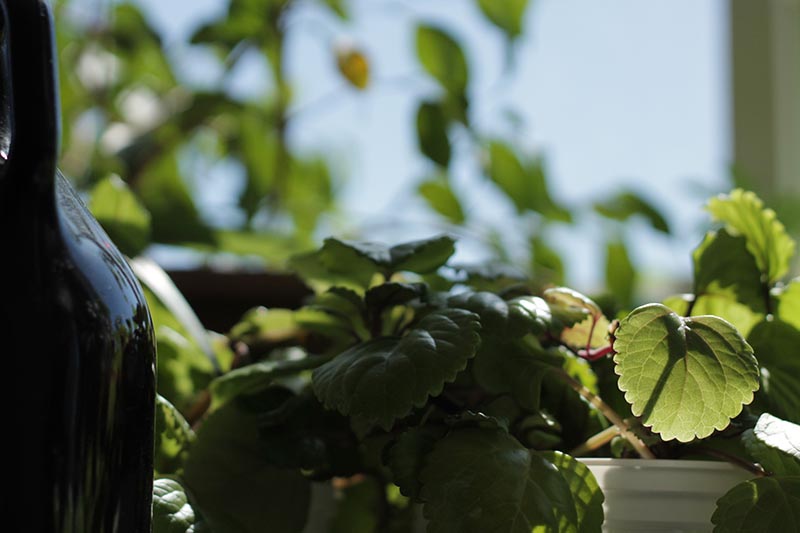
If you live in Zones 10 or 11, you can grow this plant outdoors, where it shines in a border.
Or, keep it in a container or hanging basket and set it on your porch during the summer for a cheerful welcome to any guests who come over.
Quick Reference Growing Guide
| Plant Type: | Evergreen flowering perennial | Flower/Foliage Color: | Lavender/green (or variegated, purple) |
| Native to: | Southern Africa | Tolerance: | Low light |
| Hardiness (USDA Zone): | 10-11 (outdoors) | Maintenance: | Low |
| Bloom Time: | Fall (rare indoors) | Soil Type: | Indoor plant mix |
| Exposure: | Indirect sunlight | Soil pH: | 5.5-6.5 |
| Time to Maturity: | 3-5 years | Soil Drainage: | Well-draining |
| Planting Depth: | Depth of the root ball | Uses: | Houseplant, hanging basket |
| Height: | 2-3 feet | Order: | Lamiales |
| Spread: | 2-3 feet | Family: | Lamiaceae |
| Water Needs: | Moderate-low | Genus: | Plectranthus |
| Common Pests and Diseases: | Gnats, mealybugs, spider mites; leaf spot, root rot | Species: | Coleoides, purpuratus, verticillatus (mis. syn. australis) |
Minty Fun
There’s something energizing about the smell and look of a mint plant, and this mint relative may just give you the burst of energy you feel you’ve been lacking.
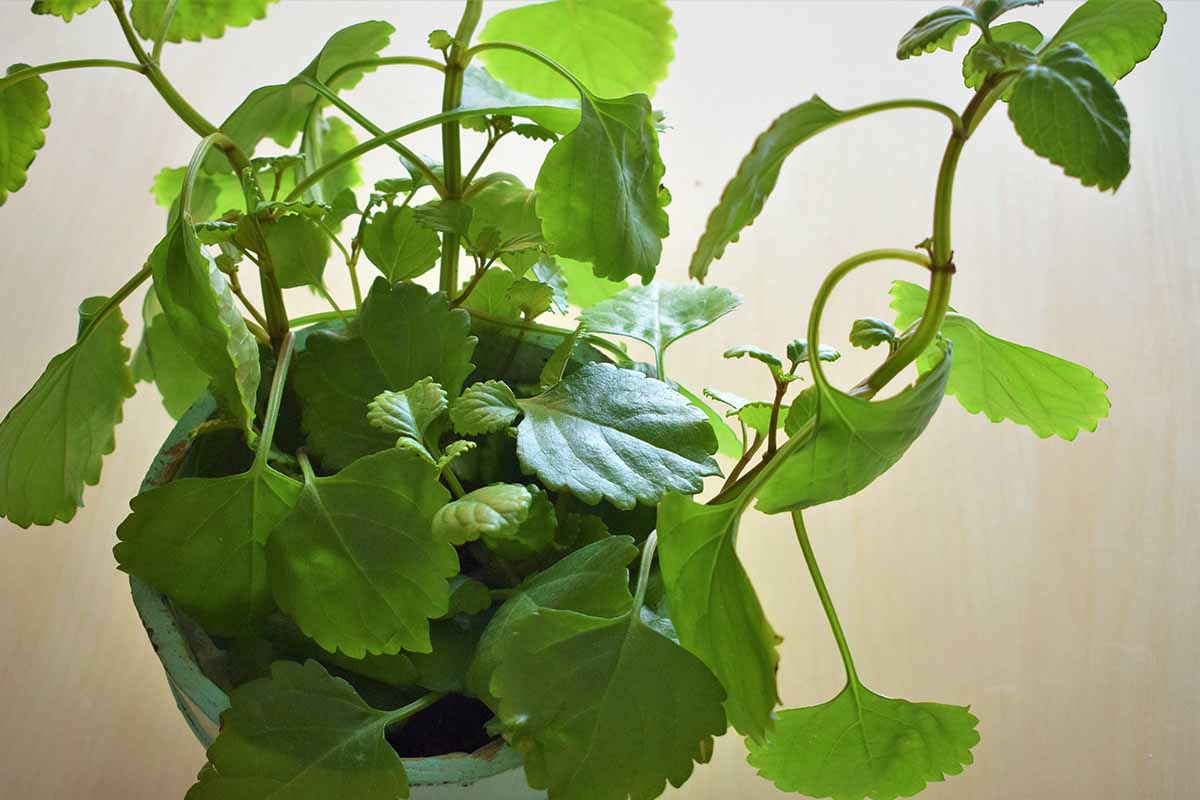
Have you ever grown one of these houseplants? Or, even better, have you ever inherited a cutting from the Oval Office? We would love to hear your Swedish ivy stories. Leave any anecdotes or questions in the comment section below!
And remember to check out these articles about growing other houseplants next:
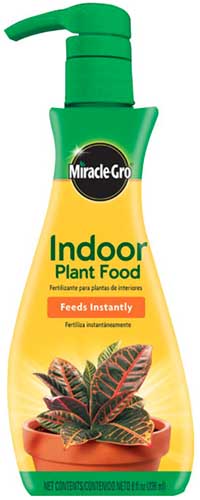
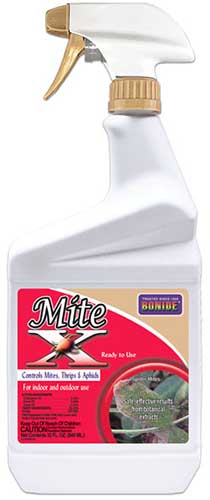

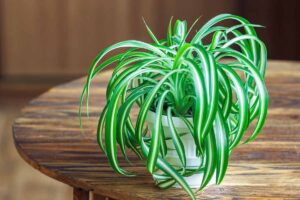
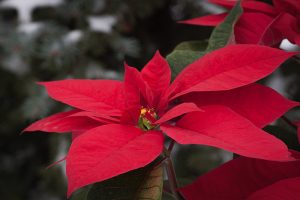

Swedish Ivy also has a history in Alcoholics Anonymous. When Bill Wilson, one of the founding fathers of AA, was hospitalized in 1971 he was given a Swedish Ivy. After he passed away his wife Lois Wilson brought that plant home. Later, shoots and cuttings from that plant were gifted to Bill’s friends. Today there are people from all over the world who have ‘descendants’ from that original plant.
My wife recently received a Bill W plant from her Sponsor! We love this tradition and plan on continuing it with our Sponsees.
The tradition of a Swedish Ivy plant — or plants — on the fireplace mantel of the Oval Office continues. My adult daughter confirmed it during a recent tour of the West Wing.
How neat- thanks for sharing, Linda!
Hi I have many of them and yes I give them to people as they are very easy to start how ever I have 3 with red stems and red veins in the leaves ? They have all been started from 1 start of of one I got for my daughter. I am also a friend of Bill W and did not know that. Anyway does any one know why 3 of them have red stems and veins ? I think it must be a soil difference ? or more sun they do get more sun but I am not… Read more »
Hello, Tasha! The discoloration on the three with the veins and red stems is probably getting too much direct light. These plants, as I’m sure you know after so many years of Swedish ivy growing success, prefer bright but indirect light.
It’s delightful that you are sharing so many starts, keep up the good work.
I was introduced to Swedish Ivy at New York State University Farmingdale NY in 1962. I rooted a couple pieces in my Dormitory Then took them home where we had a Flower Shop & Greenhouse business. I have been growing Plectranthus ever since as 4-6″ pots & hanging baskets from those original little cuttings.. I tell all my customers, If I can keep them going for 60 plus years, They should have good luck also!!!
Thanks for sharing Ray! Over 60 years, that’s quite a feat!